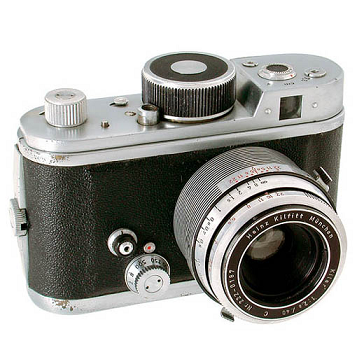
![]()
Sociedad Ibero-Americana de la Historia
de la Fotografia Museo Fotográfico y Archivo Historico "Adolfo Alexander"
Fórum Yahoo [maquinas russas]
Metzmecaflex
he Mecaflex SLR was made 1953 - 1958 at first by Metz Apparatefabrik,
Fürth, Germany later by S.E.R.A.O. Monaco It was constructet by Heinz Kilfitt,
who also supplied the lenses (Kilfitt Kamerabau, Vaduz, Liechtenstein) The top
cover hinges forward to reveal level reflex finder, advance lever, counter etc.
50 exposures 24x24mm on standard 35mm film are possible Interchangeable lenses:
Kilar 3,5/40 & 2,8/40 Benoist-Berthiot 2,8/40 Shutters: Prontor-Reflex or
Prontor Value today $1000 +
|
Heinz Kilfitt was was the designer of the famous Robot cameras. In 1941,
he bought a small factory in
Heinz Kilfitt founded an optical company in Leichtenstein in 1947 that
was subsequently relocated to
When he retired in 1968, he sold the factory to Dr. Frank Back, who
operated it under the Zoomar name from its headquarters in
Iit subsequently restricted itself to military optics only and left the
civilian market in 1986. The entire Kilfitt/Zoomar lens line is most
impressive. The most highly sought after lenses are the 2.8/90 Makro-Kilar, the
4/300 Pan-Tele-Kilar, and the two Zooomatars, 5.6/500 and 1000 catadioptric
lenses
Every Kilfitt lens was tested before leaving the factory. Film was not
considered flat enough for accurate tests, so it was shot on glass plates --
two of them. One plate went out with the lens, the other stayed at the factory
for future comparisons if the lens was ever returned for repairs. The lenses
were bolted to a tripod head mounted in concrete in the basement of the Kilfitt
factory. Mr. Kilfitt wanted to turn out quality lenses, and he did. Not only
did he make lenses, he also designed cameras. The Robot, the Mecaflex and the
Kowa 2 1/4 are all Mr. Kilfitt's designs. Kilfitt's and Zoomars are fine lenses
of great precision and optical performance, but today they are hard to find --
at least in the
After the war he worked for Heinz Kilfitt as a mechanical designer, and
was the main designer of the very advanced Kilfitt SLR with a super fast metal
bladed shutter. Unfortunately that camera never was produced, and only a few
prototypes were built. I don't think anyone knows what became of those.
The 300 and longer non-mirror lenses are more likely to have coating
problems than not, leading to believe the factory coating on large lens
surfaces was often not up to the challenge. Well known for optical innovation,
Kilfitt specialized in two areas: macro lenses and zooms - his factories
invented both. In 1955 Kilfitt made world's first 35mm macro lens, the 40/2.8
Kilar. In 1959 the Kilfitt factory turned out the world's first production 35mm
zoom lens, the 36-82/2.8 Zoomar. Not too bad for an independent factory
Yes, Mr. Kilfitt designed medium format cameras!

Heinz Kilfitt
camera system 1954
forerunner of Fujita/Kalimar cameras

Second model
made in
large front changeable mouth apt to use all Kilfitt lenses as well as from other cameras


Fujita and
Kalimar for comparison

Here we have all Mecaflex pinciples used in medium format cameras 4x4 Komaflex and 6x6 Kowa Super.
Both share Kilfitt original designs


The Komaflex , and with auxiliary optics, size comparison with
baby Rolleiflex



The Kowa Six
and lenses

Finally the
project evolved to the famous Mamiya RB 67


Mamiya and
system
Stereo of course!

first prototype 1953
Corso Polaris
and Kilfitt org

Second
prototype 1954
cameras
using film Werner Weiser
The origins



Note that this
camera was designed when Mr Kilfitt was only 18 years old
Ein Bild vom Kilfitt Prototyp ohne Federwerk
mit einem Objektiv von Rüo,






The design and development
is reported of a high-speed in-between-lens shutter free from vibration. Any
vibration, either internally within the camera or transmitted to the camera
from the air-frame tend to deteriorate the picture quality. Shutters of the
required size (3 1/2 in. free aperture) which exist at present do not meet this
specification, because heavy masses are moved and springs are employed. The
shutter uses continuously rotating discs in main- and sub-assemblies with
properly positioned cut-outs. The drive-connections between motors and
gear-trains are effected by a recently developed
highly elastic slip-free belt. The shutter assembly is connected to the camera
housing by means of an elastic suspension. The results obtained on the
experimental model with photographic tests show the following: A comparison was
made between test photographs with the shutter at stand-still, fully open and
the whole mechanism operating. The resolution values are the same on both test
exposures. This indicates that there is no deterioration caused by shock,
vibration or other factors. Independent electronic vibration tests were
conducted to verify the photographic results. (Author)











